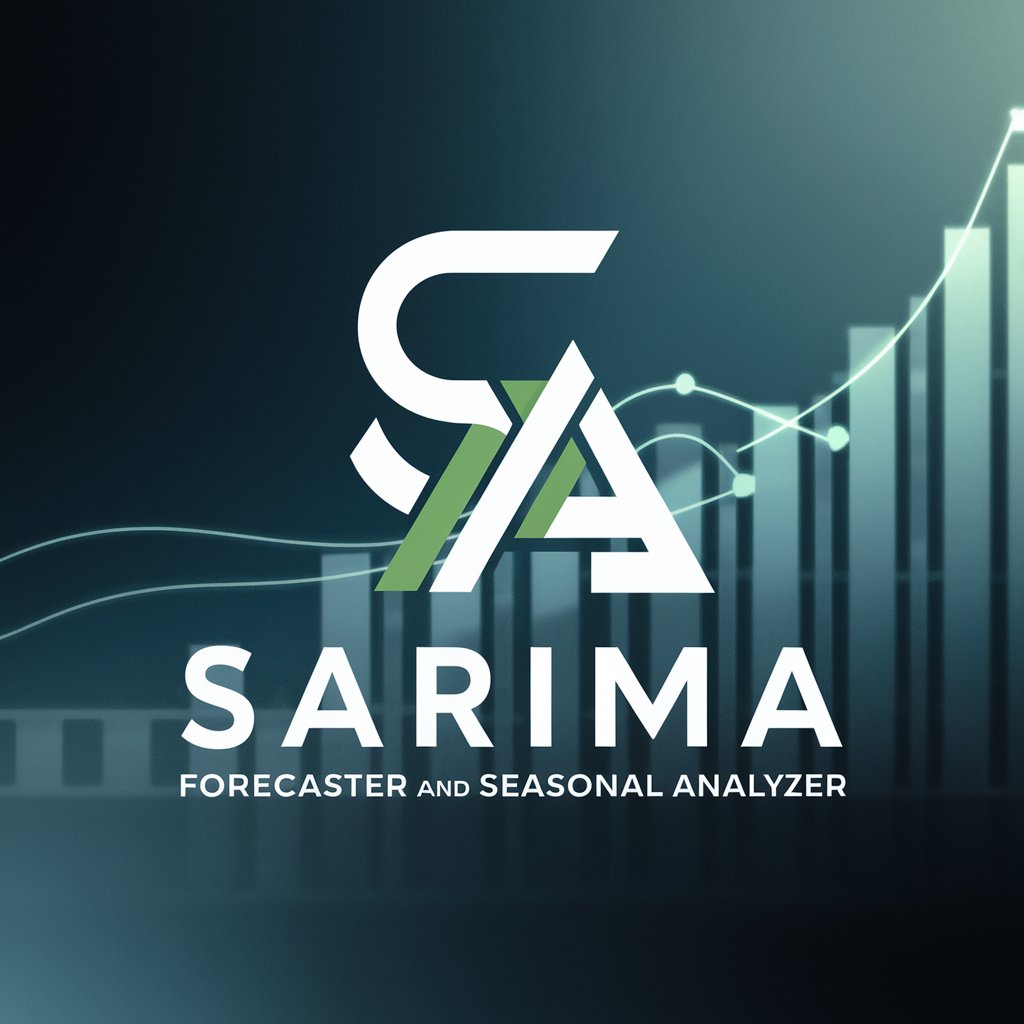SARIMA Forecaster and Seasonal Analyzer - SARIMA Seasonal Forecasting

Welcome! Ready to explore your data's seasonal trends?
AI-powered Seasonal Forecasting Made Simple
Upload your time series data to start the seasonal analysis...
Discover the hidden seasonal patterns in your data...
Get accurate forecasts for your time series data with SARIMA models...
Analyze seasonal trends and cycles with our advanced AI tool...
Get Embed Code
Introduction to SARIMA Forecaster and Seasonal Analyzer
SARIMA Forecaster and Seasonal Analyzer is a specialized tool designed to assist users in analyzing time series data, identifying seasonal patterns, and forecasting future trends. By integrating SARIMA (Seasonal Autoregressive Integrated Moving Average) models with advanced seasonal analysis techniques such as seasonal decomposition, Fourier analysis, and statistical tests, it offers a comprehensive approach to understanding and predicting temporal datasets. This tool is particularly useful in scenarios where data exhibit seasonal variances, trends, and cyclic behavior, enabling users to decompose these elements for better insight and forecast accuracy. For example, in the context of retail sales, SARIMA Forecaster could analyze monthly sales data to predict future sales, while also identifying the peak shopping seasons and the extent of sales variance due to seasonal factors. Powered by ChatGPT-4o。

Main Functions of SARIMA Forecaster and Seasonal Analyzer
SARIMA Forecasting
Example
Forecasting monthly electricity demand for a utility company.
Scenario
Using historical electricity usage data, SARIMA Forecaster could model and predict future demand, helping the utility company in capacity planning and in minimizing over- or under-supply scenarios.
Seasonal Decomposition
Example
Analyzing seasonal patterns in hotel bookings.
Scenario
By decomposing hotel booking data, the tool can reveal underlying trends, seasonal components, and irregular fluctuations, assisting hotel managers in understanding booking patterns and planning for high and low seasons.
Fourier Analysis
Example
Identifying dominant cycles in website traffic.
Scenario
Fourier analysis could be applied to daily website visitor data to identify key periods of activity, helping in optimizing content release and marketing strategies around these peaks.
Statistical Tests
Example
Evaluating sales differences across quarters.
Scenario
Using statistical tests like ANOVA, SARIMA Forecaster could assess whether sales differences between quarters are statistically significant, guiding strategic business decisions related to inventory and promotions.
Ideal Users of SARIMA Forecaster and Seasonal Analyzer Services
Business Analysts
Professionals tasked with forecasting sales, demand, or supply chain metrics would benefit from the tool's predictive capabilities and seasonal insights, facilitating data-driven decision-making.
Environmental Scientists
Scientists studying temporal patterns in climate or environmental data can utilize SARIMA Forecaster to model and predict phenomena like rainfall, temperature variations, or pollution levels.
Marketing Professionals
Individuals responsible for planning marketing campaigns around peak activity periods can leverage the tool's ability to identify seasonal trends and significant periods, optimizing campaign effectiveness.
Financial Analysts
Analysts forecasting financial metrics such as stock prices, interest rates, or economic indicators will find the tool's detailed trend analysis and forecasting capabilities invaluable for making investment decisions.

How to Use SARIMA Forecaster and Seasonal Analyzer
1
Begin your journey at yeschat.ai to access a complimentary trial, no sign-up or ChatGPT Plus required.
2
Upload your time series dataset in a compatible format (CSV or Excel), ensuring it contains clear, chronological data entries for accurate analysis.
3
Specify your forecasting objectives and any known seasonal patterns or cycles in your data to tailor the SARIMA model's parameters.
4
Review the model's output, including the forecasted values, seasonal decomposition, and Fourier analysis results, to understand future trends and seasonal effects.
5
Utilize the statistical tests provided to evaluate the significance of observed seasonal patterns, aiding in strategic planning and decision-making.
Try other advanced and practical GPTs
Anime Advisor
Discover Your Next Anime Adventure

Sarigannada
Perfect Your Kannada with AI

HasanSari
Unleash AI's potential, enrich your understanding

Sari Sari Store
Empowering Decisions with AI

Natalia Sari Data Insight UX
Empower Your Design with AI Insights

Management Consultant
Empower Your Strategy with AI

Atatürk gibi düşünmek
Insights into Atatürk's Visionary Mindset

PW Sari Sari Store Expert
Empowering sari-sari stores with AI-driven advice

Job Generator
Empower Your Career with AI

Job Interviewer
Ace Interviews with AI Coaching

Job Ace
AI-Powered Career Advancement

Job Matchmaker
AI-driven Job Discovery and Application

Frequently Asked Questions about SARIMA Forecaster and Seasonal Analyzer
What types of data are best analyzed with the SARIMA Forecaster?
This tool excels with time series data that exhibits seasonal patterns or trends, common in industries like retail (for sales forecasting), energy (for demand forecasting), and finance (for stock price analysis).
Can SARIMA handle data with multiple seasonal cycles?
Yes, SARIMA models can be adjusted to accommodate complex time series with multiple seasonalities, making it versatile for a wide range of applications.
How does seasonal decomposition help in forecasting?
Seasonal decomposition separates a time series into trend, seasonal, and residual components, providing insights into underlying patterns that can improve forecast accuracy.
What is Fourier analysis used for in this tool?
Fourier analysis identifies dominant cycles or frequencies in the data, which helps in recognizing and adjusting for regular seasonal fluctuations.
Are there prerequisites for using the SARIMA Forecaster effectively?
A basic understanding of time series data and its characteristics can greatly enhance the user experience, though the tool is designed to be accessible even to those new to forecasting.
